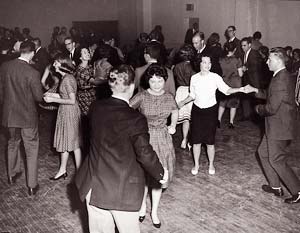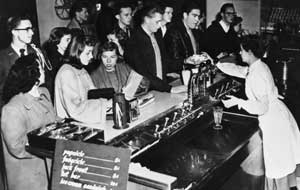This church-without-parents thing can be scary. In the first place, there is no longer any one guaranteed to wake you up on Sunday morning or poke you if you snore during sacrament meeting. And the sacrament, in a congregation lacking young children, is so silent that the Spirit is likely to wallop you and prompt you to do something risky, like bear your testimony. There is also the possibility that you might be asked to teach people older than you, some of whom have been on missions, even. And since plenty of those people are more appealing than anyone who was in your Sunday School classes growing up, teaching them can take a lot of courage.
Yes, going to church at BYU takes some getting used to. No parents, no Primary, no cushy benches, no deacons to pick up fast offerings or pass the sacrament, no grandparent types to give out hugs and casseroles–no one but students (and the bishopric, of course) running anything. It’s enough to make you kneel down and figure out why you come to church, if you don’t already know.
And that, says BYU stake president Van C. Gessel, is pretty much the point of a student ward: Build testimony and capacity in young adults by allowing them to worship with their peers and shoulder all the work of a ward. If a few marriages can be built along the way, so much the better.
THE FIRST CAMPUS WARDS
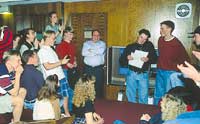
Campus wards allow students to share and develop their talents for planning, teaching, compassion, and even comedy.
Gospel leadership and temple marriages weren’t exactly the stated objectives of the faculty committee who, in 1940, recommended the creation of a priesthood program, a Sunday School, and a Mutual Improvement Association on campus. But the committee did predict that Church programs would foster “a dynamic religious environment at the university” and “a more effective social organization of the student body” (Ernest L. Wilkinson, ed., Brigham Young University: The First One Hundred Years [Provo, Utah: BYU Press, 1975], vol. 2, p. 351).
Early in this century many BYU students were Utah County kids who went home on weekends. The remainder attended local Provo wards, and when university enrollment topped 2,500 in the late 1930s, those meetings started to get unmanageably crowded. The 1940 recommendation provided a solution, but granting ecclesiastical power to a university was something new, and the board of trustees deliberated for a year before approving the concept. The first Sunday School and Mutual meetings for students were held in October 1941, soon after the completion of the original Joseph Smith Building with its large auditorium.
Enrollment dwindled during World War II, but the need for student Church units was even more apparent after the war, when campus was brimful of veterans. During the summer of 1947 the university organized a Wymount branch for married students and a campus branch for single students.
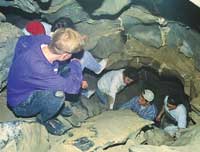
The Nutty Putty caves are a popular destination. Wards are known for planning lively, wacky, activities – and for sparking romances.
Those involved might not have foreseen how fully student wards would come to define the BYU experience. But by the time the first student stake was established in 1956, the benefits of campus church units were obvious. Years later BYUPresident Ernest L. Wilkinson called the establishment of student wards and stakes the most significant accomplishment of his 20-year administration.
In proposing the formation of a BYU stake, Wilkinson had an eye toward social as well as ecclesiastical opportunities. Concerned about the exclusivity of social units and the inevitable inability of the student government to meet the social needs of a burgeoning student body, a faculty committee argued in 1954 that “the stake organization could take over much of the overall student body social activities” (First One Hundred Years, vol. 3, p. 345).
And so it has. The first BYU stake had 12 wards of about 500 students each. By 1960 there were three stakes on campus, composed of 28 wards with an average of about 350 students. And in 1962 when the wards had essentially made them obsolete, campus social units were officially discontinued. Today there are 20 BYU stakes and one Orem student stake, with a total of 235 wards; five of the stakes and 49 of the wards are for married students. The average ward has about 180 members.
Wards are now kept small so that bishops can minister effectively and students can have more leadership opportunities. Such a ward also gives students a ready-made peer group small enough to foster belonging yet large enough to be socially interesting. “The wards make this big, impersonal university manageable and cut it down to size for students in so many critical ways,” says John S. Tanner, ’74, chair of BYU‘s English Department and a former campus bishop and stake president.
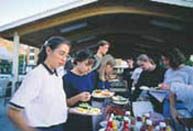
Students from a campus ward barbecue on Deseret Towers field. Ward leaders usually try to include and involve every student.
ADVENTURES IN CHURCH LEADERSHIP
While they do, of course, follow standard LDS patterns, campus wards nevertheless have a culture and a logic all their own. For example, at BYU it’s normal to have two fully-staffed Relief Societies in a ward. It’s normal to have sacrament meeting in a chemistry classroom. It’s normal to gather with your entire ward for prayer and singing every Sunday night. And in most wards it’s understood that unless you stand up as soon as the bishopric turns the time over, there’s no guarantee you’ll get to bear your testimony.
The average BYU ward has always had more talent and enthusiasm among its ranks than it can fully employ. This is why wards often opt for multiple Relief Societies or elders quorums and create such nontraditional but genuinely useful positions as “ward prayer coordinator.” And though many bishops make sure everyone has a calling, there is always a surplus of leadership.
“Students that are accepted at BYU now are top-notch,” says Susan Winder Tanner, ’84, wife of John. She was active in BYU wards during the 1970s and has sent four of her children to BYU. “So you get 200 of these leader types in a ward; 75 girls could all be Relief Society president, and one of them gets called to pass out the hymn books. I think that can be a frustration. They don’t feel like they’re being used to the best of their potential.”
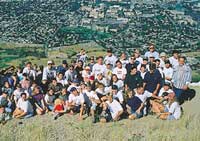
Hiking the Y is a common ward activity. After a student stake was created in 1956, wards replaced social units as the primary source of activities.
Still, most students see more service on campus than they would at home. “In my stake we have in each ward–and I’ve got 13 wards–two elders quorums and two Relief Societies,” says Gessel, president of the BYU 16th stake and dean of the College of Humanities. “So we’re giving leadership experience to twice as many people.” Because wards are small and turnover is high, he adds, “People who otherwise would not get that leadership experience are getting it here.”
According to Gessel, preparing young adults for future Church service is one of the purposes of campus wards. Most LDS college freshmen have at best very foggy notions about things like Church handbooks and ward councils. Few of them have paid fast offerings, given priesthood blessings, or done much visiting teaching–hence the beauty of campus wards, where you learn how the Church works by working it yourself.
Because the typical BYU ward is far more compact and homogenous than any ward anywhere else, unity comes naturally. Everyone is roughly the same age and at roughly the same stage of career preparation. Everyone has the same marital status. And in some complexes every member of the ward pays the same amount in rent and lives in an apartment that looks exactly like everyone else’s.
Shawna McGregor Driggs, ’91, says the homogeneity makes campus wards a good place to practice for future Church service. “You get an insight of how a ward can and does (and sometimes doesn’t) function within a controlled, safe environment,” says Driggs, who served as the Relief Society president of a BYU ward when she was 19. “You still have issues, but you have issues that are your age group’s problems–you’re not trying to deal with issues that are beyond your experience. It gives you confidence that you are able to hold that position in a later, full-functioning ward.”

Ward members cooperate in a team-building activity. Because of their homogeneity and limited size, student wards often have a natural unity.
A concentrated ward population can also make it easier for leaders to address members’ needs. For example, apartment-complex proximity has allowed some ambitious activities committees to give every ward member a face-to-face invitation for every activity. And with their boundaries sometimes smaller than a city block, BYU wards typically achieve high percentages of home and visiting teaching.
Ward leaders are careful to train students for all these stewardships, says John Tanner. As bishop of a freshman ward, where “sometimes our elders quorum presidents had just been released from their callings in the priests quorum a few weeks before,” he says, “I always took every occasion I could to teach about the Melchizedek priesthood.”
Leadership training continues in married student wards, says John M. R. Covey, president of the BYU 17th stake. Most students in his stake have been married less than two years, Covey says, and he focuses on training them for Church service within their families. “We want people to rejoice in that big, heavy assignment–being a father, being a mother, being a husband or a wife,” he says. “When you get the vision of family and marriage and children, then you’ve got the vision of what Relief Society is all about. Then you’ve got the vision of what the priesthood is all about.”
John Tanner was an associate academic vice president in the mid 1990s when the university conducted a self-study, and he says the study’s findings underlined the value of campus wards: “When the students told us about their most importantBYU experiences, the most life-changing experiences, they often related it to firesides, devotionals, leadership experience in the wards, testimony meetings. They were spiritual highlights.”
“From the university perspective the wards are so critical,” he adds. “It is hard to overstate that.”
ROMANCE AT FAMILY HOME EVENING
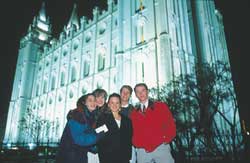
BYU wards nurture students’ testimonies, train future leaders, and often produce lifelong friendships.
Many BYU wards print directories that feature mug shots (and sometimes sketched caricatures) of their members. These are an important resource, not only for leaders pondering over home teaching assignments but, more generally, for ward members in search of dates–and for their similarly motivated friends who may pick up the “shopping list,” as wards have been known to call them.
What with graduations, marriages, internships, and random housing changes, these directories have a very short shelf life. Campus wards ebb and flow (and may change flavors) every semester. This requires the bishopric to memorize new faces and make significant staffing changes every few months. And it means that student ward relationships are often transitory. Yet the wards forge some of the strongest bonds made at BYU.
Family home evening is one of the prime bonding times. Generally larger than the common domestic type, a campus FHE group is more likely to spark romances–and more prone to wacky behavior. BYU family home evening groups are notorious for planning outings like supermarket scavenger hunts or trips to watch the Brigham Young statue do the “funky chicken.” In fact, in 1974 the exuberance of FHE groups prompted Church leaders to warn students against creating a playground atmosphere on campus. Of course the groups also serve up more traditional fare, like party games, brownie baking, and lessons.
And family home evening groups are just one piece of the ward activities pie. A student ward may sponsor intramural sports teams or organize its own volleyball tournaments. Student wards typically end their fast Sundays with huge potluck feasts. Summertime brings trips to the Manti pageant, outings in the canyons, even river-rafting excursions. These are in addition to activities common in traditional wards, such as ice cream socials, temple nights, firesides, dances, and service projects. The activities committee of a singles student ward probably stays at least five times as busy as their family ward counterparts.
All this social activity provides a seedbed for no small number of lifelong friendships, including marriages. The apparently innocuous decision to rent a particular house or apartment, and therefore to belong to a particular campus ward, often has eternal consequences of the most significant kind.
As nearly everyone hopes. When students anxious to sell their housing contracts promise prospective buyers a “great” ward, they’re generally advertising an abundance of eligible peers or complimenting the ward activities committee–not making claims for superior spirituality.
Stake and university leaders aren’t concerned about putting together “fun” wards per se, but they do “whatever we can to have an appropriate balance of males and females in a ward,” says Mark J. Rowe, associate dean of the College of Biology and Agriculture and the university’s official liaison with the student stakes. Because the off-campus housing mix changes constantly, he says, “We go to a tremendous effort every year to alter boundaries.”
While leaders’ primary emphasis is spiritual shepherding–caring for students and giving them leadership opportunities–they don’t neglect social concerns. “Part of the program is obviously to get them to move from the single stake to the married stake,” says Gessel.
But “sometimes the social group can get in the way of the spiritual,” says John Tanner. As a BYU stake president he tried to discourage “ward-hopping”–the practice of visiting different wards in hopes of meeting someone to date–and teach students to worship and serve with their neighbors. Yet he also understands the dreams that motivate that kind of searching. “People come to BYU, and to student wards generally, with a lot of hopes and expectations that the ward will provide social opportunities,” he says. “It can be very frustrating and actually demoralizing for some if they’re not dating as much as they’d like or if nobody is interested in them.”
To address such concerns, most bishops in singles wards encourage dating and marriage. While serving as bishop of the BYU 43rd ward, Karl Marrott of Provo earned the nickname “Bishop Marriage” because, he says, “I was unmerciful with the guys. Any interview that I had with any young man I wanted to know what he was doing to find a companion.” Though he reminded 18- and 19-year-old women that they were generally too young for marriage, Marrott says he seldom gave a talk that did not pertain to marriage in some way. “There wasn’t a person in my ward who didn’t understand that it was the man’s responsibility to find a wife and it was the woman’s responsibility to be available to be found,” he says. One semester his ward produced 27 marriages.
For students who have already found their mates, campus wards continue to provide peers and training closely tailored to their life circumstances.Some things do change, of course: Married couples are expected to start their own family home evening groups. Bishops tend to emphasize child bearing and debt avoidance as well as continuing courtship. Sacrament meetings are no longer quiet–ever–and the wards often have huge nurseries. But the homogeneity and resultant unity of a campus ward persist.
Though she attended BYU in the early 1970s, Susan Tanner still remembers extra-mile service from a Family Home Evening “dad.” Her husband John remembers the testimony of an elders quorum instructor–and the way one of Susan’s talks made him fall more deeply in love with her. In student wards, “you comment about things that are close to you; you share your testimony; and you get to know people on a deeper level than you do in a class, or on a date, or at a party,” Susan says. “The way student wards are designed, we end up learning to share our souls with people.”







